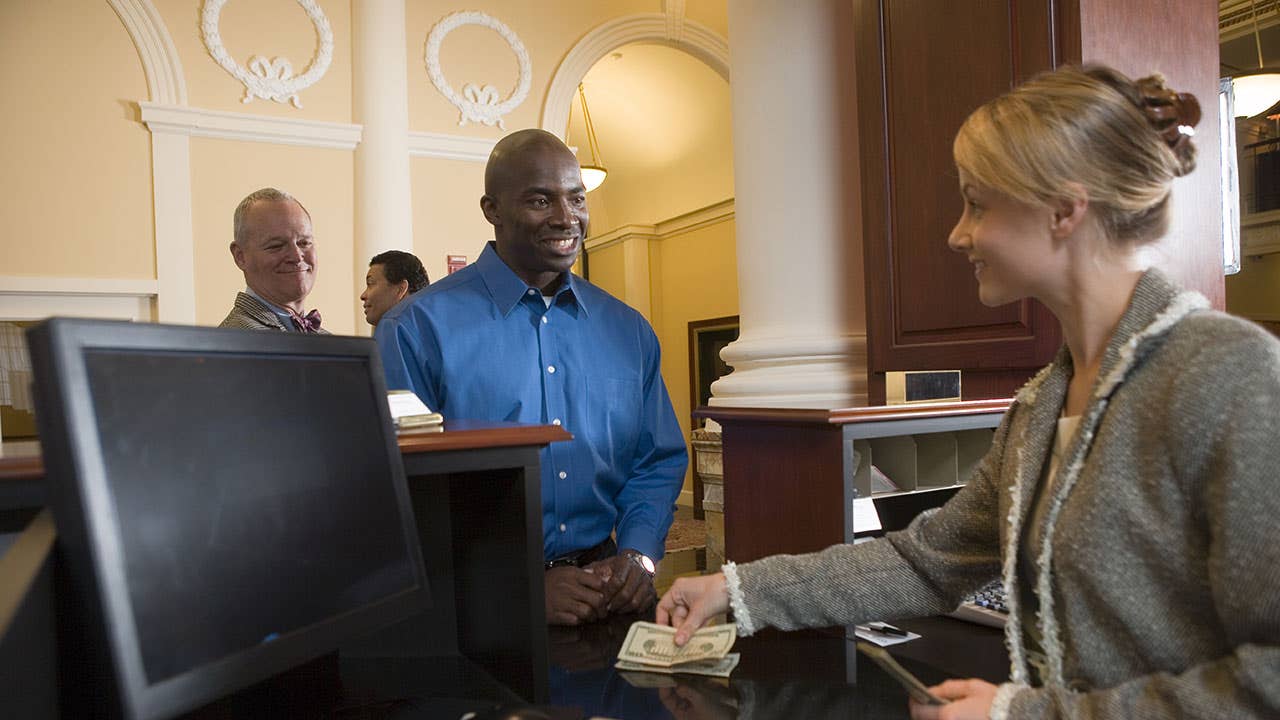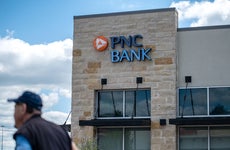How bank tellers quietly disappeared from America, and what that means for consumers

The Bankrate promise
At Bankrate we strive to help you make smarter financial decisions. While we adhere to strict , this post may contain references to products from our partners. Here's an explanation for .
A couple of tellers – and many vacant windows. This is a common scene in banks, especially in the older brick-and-mortar locations. Many of these branches were built before online banking, fintech and mobile check deposit existed.
Those innovations, which allow transactions to be conducted virtually anywhere, are just a few reasons the Bureau of Labor Statistics forecasted in 2017 that teller jobs would decline around 8 percent through 2026. Just one year after that forecast, tellers had already decreased a little more than 8 percent – from 502,700 to 481,490.
“You’re seeing that function, that traditional banking job role start to decline,” says Jim Edrington, chief member engagement officer at the American Bankers Association. “But I think more importantly you’re seeing it start to morph.”
The teller of the future does much more than accept cash deposits and fill out money orders. This employee is vital to keeping branch banking alive and relevant in the digital banking world.
The position taking the place of tellers
The future bank teller is morphing into a universal banker, says Edrington. A universal banker is a bank employee who both is on the platform – in the branch desk area where more in-depth conversations take place – and on the teller line. Edrington, who was a teller himself in college, says the universal banker made its retail banking debut around 2010.
“Right after the financial downturn you started to see that whole job wall evolve,” says Edrington.
The evolution means the separation between tellers and platform workers is quickly fading. The universal banker takes away the divide between platform and teller.
Around five or six years ago, the American Bankers Association started offering a universal banker certificate. The series of courses took off immediately, Edrington says.
“We figured, ‘Well, we’ll see the teller piece just drop off,’” Edrington says. “Well interestingly enough, the universal banker piece is going quite well. But there’s still a nice bit of education business for us around our bank teller certificate.”
Tellers still have a vital role
From customer retention to the customer experience, the teller can be the differentiator between a physical branch and an online bank. No position in the bank sees more customers than a bank teller. And consumers want personalized help, even in the online age. More than three quarters of U.S. retail bank customers are interested in receiving financial advice or guidance from their bank, according to the J.D. Power 2019 U.S. Retail Banking Advice Study.
These days, technology can help a bank teller determine what conversation might be the best one to have with a particular customer. This customized advice can be a more useful conversation for both the customer and the bank. It can be argued that the teller is even more important than ever.
“Banks have gotten smart with technology that when someone comes to the teller window or engages with a universal banker, they can pull up…their account and even recommend certain things that that bank employee should maybe mention or talk (about),” Edrington says.
A teller can be the difference between a customer simply walking in and out of a bank for what may be a rare visit, or a conversation that leads to more business for the bank in another product or service and a need filled for the customer.
“There’s a huge role here for connecting customers with the expertise, with the correct expertise inside the bank — whether that’s business banking, or mortgage or getting help with the mobile app,” says Paul McAdam, senior director, banking services at J.D. Power. “Or whatever the financial need may be.”
Fewer transactions means every customer interaction must be great
Routine branch transactions have been declining. That’s why every bank experience is crucial for the survival of brick-and-mortar banks – since for some customers, bank visits are few and far between.
“When these younger digital-only customers come in, it’s a really important moment of truth because this may only happen every two or three years,” McAdam says.
Since these digital customers bank in person so infrequently, assuming the bank interaction/visit goes well, satisfaction can go up quite a bit according to the J.D. Power retail banking study, McAdam says.
“So it can be very meaningful,” McAdam says. “Or it can be a bad moment of truth as well.”
Even though most depositors use online banking, a majority of those who use online banking still visit brick-and-mortar banks, according to the triennial Survey of Consumer Finances (SCF).
ATMs and advertisements when you login to online banking or on the bank’s mobile app can be effective in some situations. But a conversation with a teller may be the most effective approach for certain customers. Customers actually in a branch had a choice between visiting a bank or taking care of their banking via a mobile app or an ATM. So it makes sense that these customers may be more receptive to a human interaction than they are to a computer prompt.
“I think more and more are doing that,” Edrington says. “Certainly the very large banks have honed that quite well. But I think you’re seeing a lot of moves through some of the innovative technology companies out there to offer that kind of functionality to even the community banks.”
Weren’t ATMs supposed to eliminate tellers?
At Bank of America, the ATM similar to the one we are familiar with today, was piloted in September 1969. The prediction that ATMs would have eliminated the need for bank tellers decades ago would have made sense. As a Bureau of Labor Statistics article notes, tellers survived the period after ATMs were expected to lead to fewer jobs.
“I think that was the number one fear, that they would replace traditional banking or branch banking. And it never happened,” Edrington says with a laugh. “It just provided additional convenience for the customer. And the branches certainly rode that wave very effectively.”
But ATMs actually, unexpectedly, lengthened banking hours without eliminating teller job opportunities, according to a June 1982 article in Monthly Labor Review. Suburban expansion and the increase in retail branches caused demand for tellers to increase.
For some transactions, convenience and speed are more important
Technological advances in banking – from mobile check deposits to ATM check deposits and ATM cash withdrawals — may eliminate the need for a brick-and-mortar bank for some simple transactions.
“When it comes to automation — consumers are interested in getting quick answers through automated means — absolutely,” McAdam says. “Quick transactions. Quick answers. The convenience of not having to deal with the complications that can sometimes arise in a personal face-to-face communication. That’s why we love Google and we love our apps. We can get our answers very quickly.”
Some banks are utilizing Interactive Teller Machines (ITMs). These allow a face-to-face video interaction with a teller. The same teller is able to help customers at multiple ITM locations in a day because they’re based at a centralized location.
“Even branches with tellers, the interaction with that teller — it’s not going to be over a counter,” says Greg McBride, CFA, Bankrate’s chief financial analyst. “It’s going to be through a video screen. The tellers are going to be increasingly centrally located but may serve multiple branches through video technology.”
This greater efficiency is how the teller might still be around in the future.
Related Articles



LGBTQ+ friendly banking: How to find inclusive banks that support the LGBTQ+ community

Why banks are suddenly so interested in pitching ways to improve your wealth